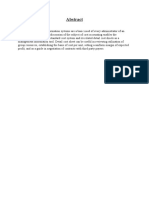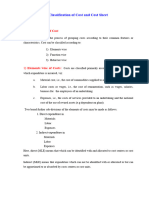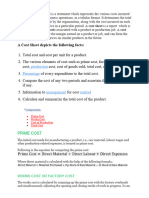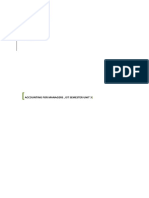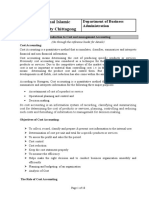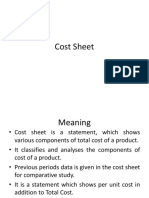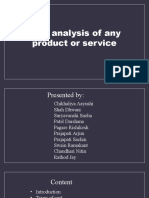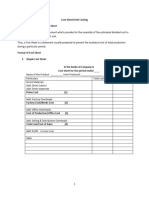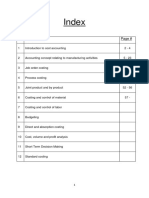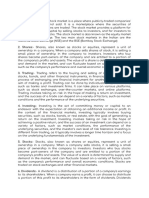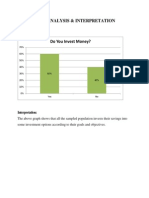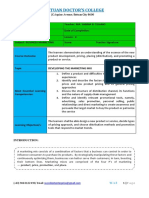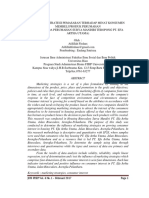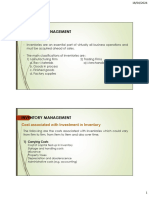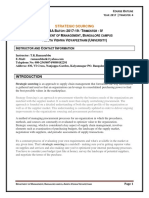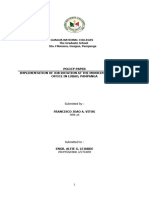SIGNUP LOGIN
Search for a topic "
Home > Fundamentals of Accounting > Fundamentals of Cost
Accounting > Format of Cost Sheet
Fundamentals of Cost Accounting
Format of Cost Sheet
A cost sheet is a statement prepared at periodical
intervals of time, which accumulates all the
Feedback
elements of the costs associated with a product or
production job. It is used to compile the margin
earned on a product or job and forms the basis for "
!
the setting of prices on similar products in the
future. We shall study the Cost Sheet Format in
detail.
Source: freepik.com
What is a Cost Sheet?
A Cost sheet is a memorandum statement that
provides the estimated detailed costs in respect of a
cost centre or a cost unit in a summarized manner.
In a Cost Sheet, the elements of cost are arranged
under different heads following a logical order. It
depicts the detailed cost of the total output for a
certain given period.
The cost sheet does not form part of the double-
entry system. In it, additional columns can be
added to indicate the cost per unit at different
stages of production.
Cost Sheet Format
A Cost Sheet depicts the following facts:
1. Total cost and cost per unit for a product.
2. The various elements of cost such as
prime cost, factory cost, production cost,
cost of goods sold, total cost, etc.
3. Percentage of every expenditure to the
total cost.
4. Compare the cost of any two periods and
ascertain the inefficiencies if any.
5. Information to management for cost
control
6. Calculate and summarize the total cost of
the product.
Learn more about the Meaning of Cost Accounting
here in detail.
Importance and Objectives of Cost Sheet
1. For calculating the total cost break-up
A cost sheet shows the break-up of the total cost
into different elements, i.e. material, labour,
overheads, etc. It also depicts the total cost and cost
per unit of the units produced.
2. For determining the selling price
A cost sheet helps in determining the selling price
of a product or of a service. The cost sheet
ascertains cost at each stage of the product and also
the total cost of the product, where a margin of
profit is added and thus the selling price is
ascertained.
Browse more Topics under Fundamentals Of Cost
Accounting
Origin and Evolution of Cost Accounting
Meaning of Cost, costing and cost
accounting
Importance of Cost Accounting
Financial Account vs Cost Account
Meaning of Management Accounting
Scope and Functions of Cost Accounting
Objectives of Cost Accounting
Advantages of Cost Accounting
Costing – an aid to management
Characteristics of an Ideal Costing
System
Classification of Cost
Methods of Costing
Techniques of Costing
Cost Unit and Cost Centre
Cost Control and Cost Reduction
Elements of Cost
3. It facilitates comparison
It helps in comparing the costs of the product over
a period of time. This helps the organisation to
investigate the reasons for increasing costs and also
control them on the basis of them.
4. Facilitating managerial decision making
Preparation of cost sheet helps managers at various
levels in their decision-making process such as
1. to produce or buy a component,
2. what price of goods to quote in the
tender,
3. whether to retain or replace an existing
machine,
4. how to reduce costs and maximize profit.
5. identify and make decisions whether
they need to continue with the product or
not.
5. Preparation of budgets
Organizations can prepare a budget with the help of
a cost sheet. We can prepare the budget by using
the current or previous year’s data.
Based on our existing cost sheet, we can make
estimates of our costs for the next financial year. It
helps to prepare and make the necessary
arrangement of funds for costs of the next financial
year
Elements of Cost
Prime Cost: It comprises direct material, direct
wages, and direct expenses. Alternatively, the
Prime cost is the cost of material consumed,
productive wages, and direct expenses.
Factory Cost: Factory cost or works cost or
manufacturing cost or production cost includes in
addition to the prime cost the cost of indirect
material, indirect labour, and indirect expenses. It
also includes the amount or units of WIP or
incomplete units at the end of the period.
Cost of Production: When Office and
administration cost at the end of the period are
added to the Factory cost, we arrive at the cost of
production or cost of goods sold. Here, we make an
adjustment for opening and Closing finished goods.
Total Cost: Total cost or alternatively cost of sales
is the cost of production plus selling and
distribution overheads.
Items excluded from Costs while preparing Cost Sheet
The following items of expenses, losses or incomes
are excluded from the cost sheet:
Related to capital assets
appropriation of profits
amortization of fictitious or intangible
assets
abnormal gains and losses or items of a
purely financial nature
Examples of such items can be:
loss on sale of fixed assets
interest on capital
discount on issue or redemption of shares
or debentures
expenses relating to the previous period
cash discounts
bad debts
damages payable
penalties and fines
interest or dividend received on
investments
transfer fees received
profit on the sale of fixed assets
appropriation of profits such as income
tax
dividend paid
transfer of profits to reserves or funds
donations and charities
excess provision for depreciation on
fixed assets
amortization of fictitious or intangible
assets such as goodwill written off
preliminary expenses written off
patents, trademarks and copyrights
written off
capital issue expenses
underwriting commission
loss on the issue of shares and
debentures written off
Proforma of A Cost Sheet
AMOUNT
PARTICULARS AMOUNT
TOTAL
DIRECT MATERIAL-PURCHASED
ADD OP STOCK OF RAW MATERIAL
LESS CL STOCK OF RAW MATERIAL
MATERIAL CONSUMED
ADD DIRECT WAGES
ADD DIRECT EXPENSES
PRIME COST
ADD WORKS OR FACTORY OVERHEADS
Factory Overheads
ADD OP STOCK OF WIP
LESS CL STOCK OF WIP
WORK COST
ADD ADMINISTRATION OR OFFICE OVERHEADS
COST OF PRODUCTION
ADD SELLING AND DISTRIBUTION OVERHEADS
ADD OP STOCK OF FG
LESS CL STOCK OF FG
COST OF SALES
ADD PROFIT MARGIN
SELLING PRICE
Method of Preparation of Cost Sheet
Prime Cost = Direct Material Consumed + Direct Labour + Direct
Expenses
Step I
Direct Material= Material Purchased + Opening stock of
raw material-Closing stock of raw material.
Works Cost = Prime Cost + Factory Overheads (Indirect Material +
Step II Indirect Labour + Indirect Expenses)+opening Work in progress-
Closing Work in progress
Cost of Production = Works Cost + Office and Administration
Step III
overheads + Opening finished goods-Closing finished goods
Step IV Total Cost = Cost of Production + Selling and Distribution Overheads
Profit Sales – Total Cost
Solved Example for You
From the following information prepare a cost
sheet.
Particulars Amount
Direct material-
80000
purchased
Direct material -Opening
20000
stock
Direct material -Closing
25000
Stock
Productive wages 22,000
Direct Expenses 5,000
Consumable stores 4000
Factory manager salary 15000
Unproductive wages 7000
Factory Overheads 12,000
Work-in-progress:
Opening stock 13,000
Closing stock 7,000
Office and administration
28,000
overheads
Opening stock of
5000
finished goods
Closing stock of
10000
finished goods
Selling and distribution
33,000
overheads
Company desires a margin of 20% profit on the
cost of sales
Ans.
COST SHEET FOR THE MONTH OF__________ FOR XYZ.
AMOUNT
PARTICULARS AMOUNT
TOTAL
DIRECT MATERIAL-PURCHASED
80,000.00
ADD OP STOCK OF RAW MATERIAL
20,000.00
LESS CL STOCK OF RAW MATERIAL –
25,000.00
MATERIAL CONSUMED 75,000.00
75,000.00
ADD DIRECT WAGES 22,000.00
ADD DIRECT EXPENSES 5,000.00
PRIME COST 102,000.00
ADD WORKS OR FACTORY OVERHEADS
Consumable stores
4,000.00
Factory manager salary
15,000.00
Unproductive wages
7,000.00
Factory Overheads 38,000.00
12,000.00
140,000.00
ADD OP STOCK OF WIP
13,000.00
LESS CL STOCK OF WIP 6,000.00
7,000.00
WORK COST 146,000.00
ADMINISTRATION OR OFFICE
ADD 28,000.00
OVERHEADS
COST OF PRODUCTION 174,000.00
SELLING AND DISTRIBUTION
ADD 33,000.00
OVERHEADS 33,000.00
207,000.00
ADD OP STOCK OF FG
5,000.00
LESS CL STOCK OF FG –
10,000.00
COST OF SALES 202,000.00
PROFIT MARGIN @ 20% ON COST OF
ADD 40,400.00
SALES
SELLING PRICE 242,400.00
Previous Next
Customize your course in 30
seconds
Which class are you in?
5 th 6 th 7 th
8 th 9 th 10 th
11 th 12 th
GET STARTED
Get ready for all-new Live
Classes!
Now learn Live with India's best teachers. Join
courses with the best schedule and enjoy fun
and interactive classes.
Ashhar Firdausi Dr. Nazma Shaik
IIT Roorkee VTU
Biology Chemistry
GET STARTED
Leave a Reply
Start the discussion...
! Subscribe !
� BROWSE
Fundamentals of Cost Accounting
Objectives of Cost Accounting
Meaning and Definition of Management
Accounting
Format of Cost Sheet
Cost Centre and Cost Unit
Classification of Costs
Methods of Costing
Elements of Cost
Cost Control and Cost Reduction
Advantages of Cost Accounting
Techniques of Costing
Download the App
Watch lectures, practise questions and take tests on
the go.
Download Previous Years
QUESTION PAPERS
Quick TIPS AND TRICKS for
Successful Exam Preparation
Download NCERT Notes and
Solutions
Learn from VIDEO lectures
CLASSES
BOARDS
EXAMS
About Us • Press • Customer Stories •
Jobs • Educators • Blog • Bytes •
Contact Us • FAQs
Terms Of Service • Privacy Policy
heap.identify('unique_identifier');


